patterns >  Esti Juango's Ravelry Store
Esti Juango's Ravelry Store
> Aflora

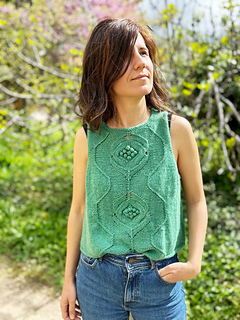
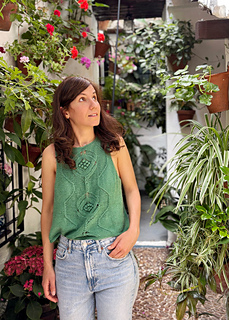
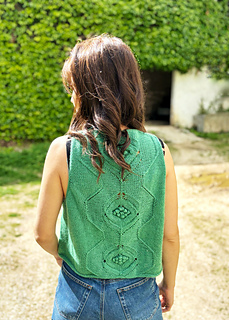
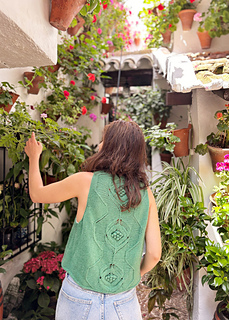


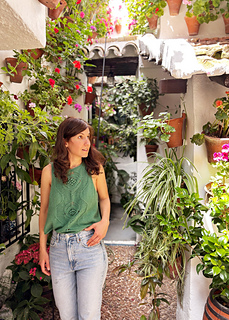
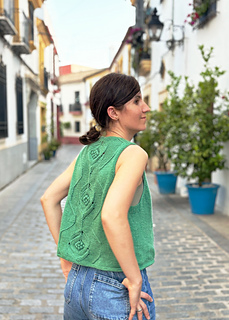
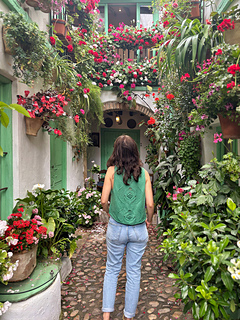
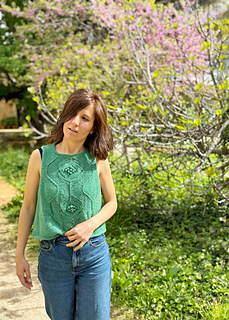
Aflora
Inspiration
Aflora is a vest or tank born from yarn and patience, where each bobble blooms like a tiny budding flower. Inspired by baroque richness and quiet craft, it balances texture and lightness in a knitted garment.
Difficulty Level
Intermediate
Pattern has been tested and tech edited.
What do you need to know?
To knit and purl, increase and decrease. To work in the round and flat. The back and front are charted and include row by row instructions. Support videos are provided for some stitches and techniques.
Sizes
1 (2, 3, 4, 5) ( 6, 7, 8, 9) with final bust circumference measurement of the top after blocking of 82 (92, 102, 112, 122) (132, 142, 152, 162) cm/ 32.25 (36.25, 40.25, 44, 48) (52, 56, 59.75, 63.75) “. A positive ease of 10-15 cm/ 4-6” is recommended.
Materials
- Yarn: Myak, Baby Yak Medium. 50 gr; 117 m (128 yds). 100% baby yak. Color: Smeraldo. Link to the yarn.
- Amount: 4 (4, 4, 5, 5) (6, 6, 7, 7) balls
- Total in m: 468 (468, 468, 585, 585) (702, 702, 819, 819) m
- Total in yds: 512 (512, 512 , 640, 640) (768, 768, 896, 896) yds
- 4 mm (US 6) circular needles for top
- 3,5 mm (US 4) circular needles for neckline finishing
- 4 mm crochet hook for the bobbles
- 4 Locking markers and 4 normal markers
- Waste yarn or stitch holders
- Tapestry needle
Gauge
In a 10x10 cm (4x4 in) gauge you should have 20 sts and 27 rounds worked in Stockinette Stitch with larger needles. .
Construction notes
The top starts at the back. It is knitted starting at the back of the neck and working down to the armholes. The stitches are then picked up to knit the front from the top-down. Neckline is shaped while knitting lacework chart to the armholes.
Front and back are then joined and worked in the round to deired length. The neck opening is finished off. The arms edges will gradually generate an i-cord finish as you knit it.
The pattern consists of the following sections:
Back
1.1 Cast on to shoulder width and straight knitting
1.2 Armhole increases to reach bust width
Front
2.1 Left front shoulder
2.2 Right front shoulder
2.3 Join fronts
Join back and front, work in the round
Finishings
---Español/ Spanish---
Inspiración
Aflora es un chaleco que nace entre hebras, donde cada bodoque brota como una pequeña planta en flor. Inspirado en la riqueza del barroco y la calma de lo artesanal, equilibra textura y ligereza en un tejido único.
Nivel de Dificultad
Intermedio
El patrón ha sido testeado y editado técnicamente
Requisitos previos
Saber tejer derecho, revés, hacer aumentos y disminuciones por el lado derecho y revés de la labor. Tejer en circular. Se incluye un esquema del calado del delantero y trasero. También las instrucciones escritas del esquema. Hay una descripción detallada de cada punto y videos de apoyo.
Tallas
1 (2, 3, 4, 5) ( 6, 7, 8, 9) con contorno de pecho en prenda bloqueada de 82 (92, 102, 112, 122) (132, 142, 152, 162) cm. Se recomienda una holgura positiva de unos 10-15 cm.
Materiales
- Hilo: Myak, Baby Yak Medium. 50 gr; 117 m (128 yds). 100% baby yak. Color: Smeraldo. Link a la lana.
- Cantidad: 4 (4, 4, 5, 5) (6, 6, 7, 7) ovillos
- Total en m: 468 (468, 468, 585, 585) (702, 702, 819, 819) m
- Agujas circulares de 4 mm para el top
- Agujas circulares de 3,5 mm para el cuello
- Ganchillo de 4mm para los bodoques
- 4 marcadores tipo imperdible y 4 normales
- Imperdible o hilo adicional para dejar puntos en espera
- Aguja lanera
Tejido de Muestra
En una muestra tejida en circular de 10 x 10 cm en punto jersey obtendrás 20 puntos por 27 vueltas con una aguja de 4 mm.
Notas de construcción
La prenda se inicia en la parte trasera. Se teje iniciando en la parte trasera del cuello hacia abajo hasta llegar a la sisa. Se recogen los puntos para tejer la parte delantera de arriba abajo. Se da forma al escote y se trabaja el calado simultáneamente hasta llegar al bajo de la sisa.
Se une el delantero y trasero y se trabaja en circular hasta la longitud final deseada. Se remata el cuello, ya que en los brazos se irá generando una terminación en i-cord conforme lo vas tejiendo. El patrón consta de las siguientes secciones:
Trasero
1.1 Montaje de puntos hasta alcanzar anchura de hombros y tejido recto
1.2 Curvatura de sisa hasta alcanzar anchura pecho
Delantero
2.1 Hombro delantero izquierdo
2.2 Hombro delantero derecho
2.3 Unión delanteros hasta sisa
Unión delantero y trasero. Tejer en circular
Acabados
2733 projects
stashed
3119 times
- First published: October 2025
- Page created: November 1, 2025
- Last updated: December 16, 2025 …
- visits in the last 24 hours
- visitors right now




